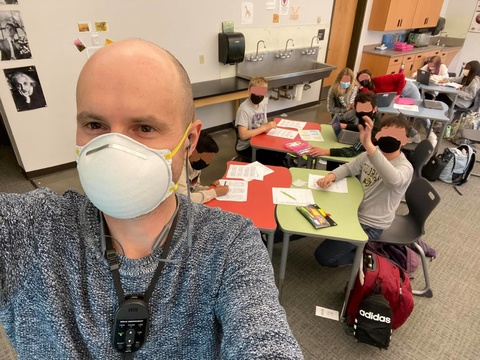When COVID-19 hit in spring 2020, teachers went above and beyond to meet the needs of their students. Adam Perkins, who received a M.A.T. in Science Education in 2010 and helped start the University of Iowa Student Demonstration Garden, is one of these teachers.
Perkins teaches science at Summit Middle Charter School in Boulder, Colorado.

At first, his school transitioned to completely asynchronous, online learning. The school received great feedback from parents and families and even put together a graduation at a drive-in to give students a meaningful end-of-year celebration.
The following summer involved preparations to introduce synchronous elements to the course delivery plan. Perkins and his colleagues spent hours mastering Google Meet and practicing as if they were taking each other’s classes. When students arrived in the fall, they were prepared.
Teaching science and conducting experiments virtually is no easy task. Perkins had to be creative using common materials students might have at home. If students couldn’t access necessary materials, he prepared bags of materials for pickup or drop-off.
One experiment Perkins had the students complete at home to learn about evolution included building fake bird beaks in various sizes and using them to eat food like seeds off a plate to replicate the finches studied by Darwin in the Galapagos islands. The students gathered data at home and put it together on spreadsheets within online small groups to increase the amount of data they had to work with. This allowed them to work collaboratively and independently at the same time.
Perkins’ biggest fear in online learning was maintaining connections without being face to face. Even when some students returned in-person, masks made it difficult to see their facial expressions.
Some days, Perkins simultaneously taught science to students in-person and online. He says it took an incredible amount of technological wizardry and patience to assure all students could hear and see everything.
Despite some challenges, everyone felt a great sense of achievement once they were back together, and Perkins says he could tell students genuinely wanted to be there.
“We all patted each other on the back, every single one of us, teachers and students alike,” Perkins says. “It was just amazing to think that we were afraid to take on all these new tasks and responsibilities and get through it. It allows us to see how much more we can do now that we’re back together.”
Perkins believes that this whole experience shows how our schools are the hub of communities and that education and educators should be supported.
“I don’t want us to just easily forget how difficult it was when we didn’t have those places of community open to people,” Perkins says. “We can make it an even better place if we really value it, not just in terms of our time, but also our tax dollars.”
As the pandemic surges on with the variants, Perkins says, “Teachers can make the most profound difference by setting an example in their communities by getting vaccinated and wearing masks indoors. It could literally save lives.”